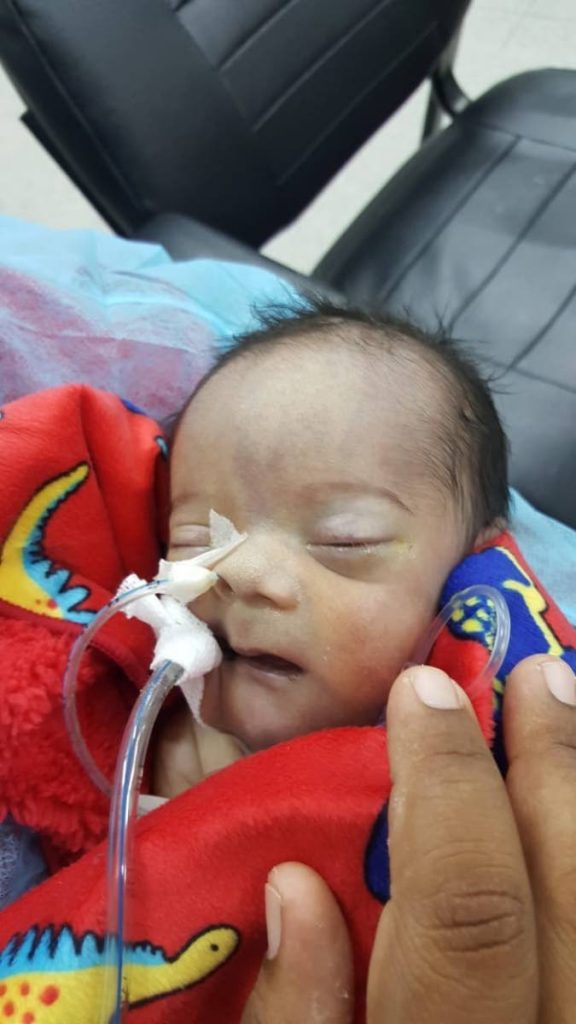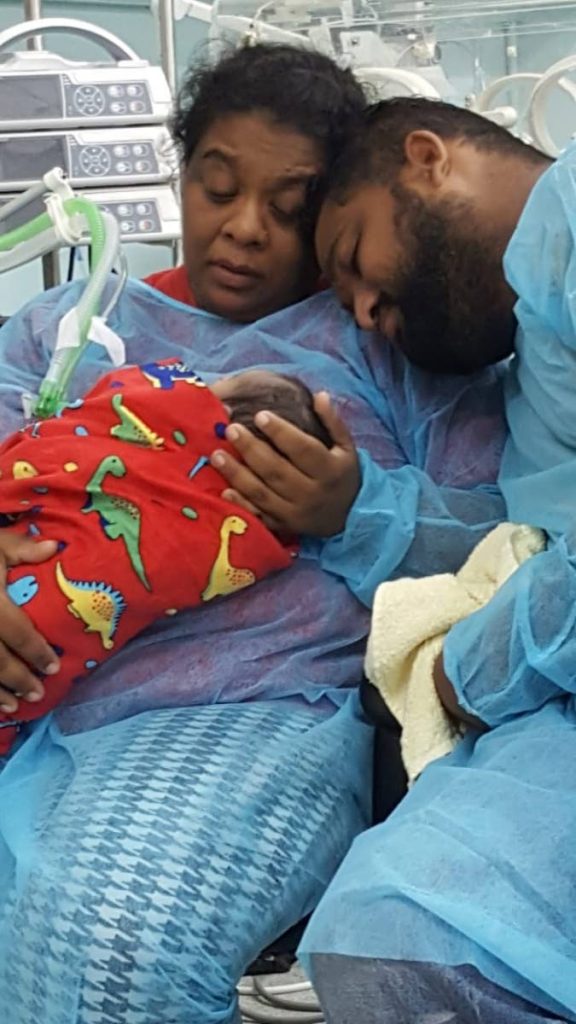Why did Jeremy die?

Valdeen Shears
Savita Basdeo-Lochan was prepared to take a bouncing baby boy home earlier this month.
Instead, she buried her newborn son, less than one week after his birth on September 18.
The 38-year-old mother of a two-and-half-year-old boy is further saddened that her son will always be an only child.
Basdeo-Lochan and her husband, Jerome Bernard, had decided “two sons was enough” and had signed consent forms, giving doctors permission to remove her tubes after the second birth.
Now, she wants answers and has taken to social media to share her ordeal. A post shared under the name Shaiya Lochan read:
“Please share....my husband and I are mourning the death of our 3 days old son who died of questionable circumstances at the San Fernando General Hospital ... we are asking parents (whose) babies may have died of similar circumstances to message or call to come together and ask questions to get the answers...the truth....our son was born healthy and strong and was taken to nursery for oxygen to steady his breathing..the next morning he was in an incubator with tubes in his stomach, nose, mouth and drips on his hands and 2 days later he died of heart attack due to sepsis, if you have or know anyone that has gone through this over the past few weeks or months please contact me to take this to higher authorities to ensure it doesn’t happen to more helpless babies...”

Basdeo-Lochan now takes solace in the number of people who have reached out to her, to share their own experiences. Together, she said, they have decided to form a support group.
One mother suffered the loss of her baby 15 years ago, while a father spoke of losing his baby under similar circumstances only last year. Basdeo-Lochan said the man claims the cause of death had also been “cardiac arrest due to sepsis”.
While the couple, of Rochard Road, Penal, have photos of them holding the baby, who they named Jeremy Aiden Sylvester Bernard, Basdeo-Lochan claims she never got a chance to hold him while he was still alive.
“He had tubes all over, they adjusted them and I sat next to his incubator and I held my son for the first time. There was no joy in it, though, cause I knew he had already passed away. His tongue was blue. His eyes swollen. I looked at the monitors, the readings were too low for a living baby. His skin upon touch was cold and white, no pink. I knew in my heart he was dead,” she recalled tearfully.
According to Basdeo-Lochan, she had an uncomplicated pregnancy, despite being hypertensive and was warded on September 17. She was 38-and-a-half weeks pregnant and opted for elective Caesarean section, because she felt “it would prove least risky to her baby’s health”.
She recalled a delay in her surgery due to an emergency with another patient. The next day, September 18, her son was delivered via C-section and weighed just under six pounds.
He did not cry immediately after delivery, but was suctioned and then she heard his cries, she said. He was brought briefly to her bedside, even as doctors worked on completing her procedure.
Then she was informed he needed “a little oxygen to settle down and steady his breathing”.
It was the last she saw him breathing on his own, she said.
Basdeo-Lochan said when her baby was not brought by her bedside, she inquired and was told he had been taken to the nursery.
Her husband, she said, returned to her bedside, excited about seeing their new son. He told her their baby was crying, moving a lot in his cot and did not have a mask attached to him.
The couple reasoned that he had been given the oxygen and would soon be in a cot next to her.
However, the following day (September 19), she was informed that she had “a very ill baby and he had taken a turn for the worst”.
Her son, she said, was eventually placed in an induced coma. She was told this was necessary, as his movements could hamper the machines from delivering the medications.
Two days after his birth (September 20), Basdeo-Lochan was discharged, but Jeremy had to remain at hospital.
“It was the most difficult thing I have ever done in my life. Leaving him there, I knew in my heart I probably was not going to take him home,” she said.
The following day (September 21), she got a call from doctors, informing her that their son, had suffered a cardiac arrest.
Her husband was stuck in traffic, on his way back from work, so her parents hurriedly dropped her off at the hospital.
Basdeo-Lochan said when she saw her son, “his colour had changed and his hands and feet were blue”. She was then informed that her baby was born with a heart condition.
Doctors, she said, told her he had developed sepsis and his “prognosis was not good”. Basdeo-Lochan said she was also told that her baby was not showing any signs of improvement or recovery.
Within an hour of returning home, they were informed that Jeremy had suffered a second cardiac arrest and were asked to return to the hospital.
“I knew it was their polite way of saying he had died. I had felt it in the car going home. My chest got tight, I couldn’t breathe and I knew the moment he took his last breathe, even though I had never gotten the chance to hold him,” she said sorrowfully.
In the early hours of September 22, they left the hospital.
While on the way home, she said, they were again asked to return and were told that doctors were going to take him off the machines, to see if he would breathe on his own.
“I just couldn’t do it. I knew he was not going to breathe again, cause he was already dead when we left the hospital. Again that was just formality and would enable them to offer a time of death,” she stated.
They went back, but only her husband returned to the room and watched as doctors pronounced Jeremy dead at 2.19 am on September 22.
His death certificate read “cardiac arrest due to sepsis”
Basdeo-Lochan said there is no history of heart disease in her family. She claims that even her doctors expressed shock over her baby’s death, as they were all in the room when he was delivered.
Last Wednesday, Basdeo-Lochan received a call from the complaints unit at the hospital, instructing her to visit their department to lodge a formal complaint.
Sunday Newsday contacted South West Regional Health Authority CEO Keith McDonald who said he was awaiting a response from doctors involved in the care and treatment of both mother and baby.
WHAT IS SEPSIS?
Sepsis is a term for severe infection that is present in the blood and spreads throughout the body. In newborns, it is also called sepsis neonatorum or neonatal septicaemia.
Sepsis can develop following infection by micro-organisms including bacteria, viruses, fungi, and parasites. Infection in babies can be contracted during pregnancy, from the mother’s genital tract during labour and delivery, or after birth from contact with others.
Sepsis in a newborn is more likely to develop when the mother has had pregnancy complications that increase the likelihood of infection. Complications may include:
• Premature rupture of the membranes (amniotic sac), or membrane rupture for an extended length of time
• Bleeding problems
• A difficult delivery
• Infection in the uterus or placental tissues
• Fever in the mother
Babies can also develop sepsis by contracting infections after birth from infected people or objects. Babies in the newborn intensive care unit are at increased risk for acquiring nosocomial (hospital-acquired) infections.
(Source: Stanford Children’s Health)


Comments
"Why did Jeremy die?"